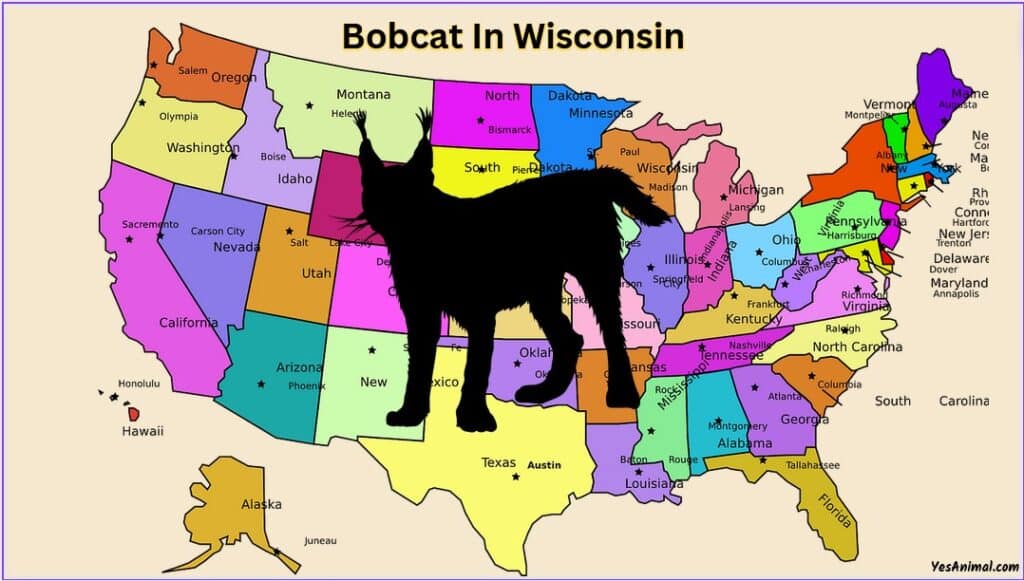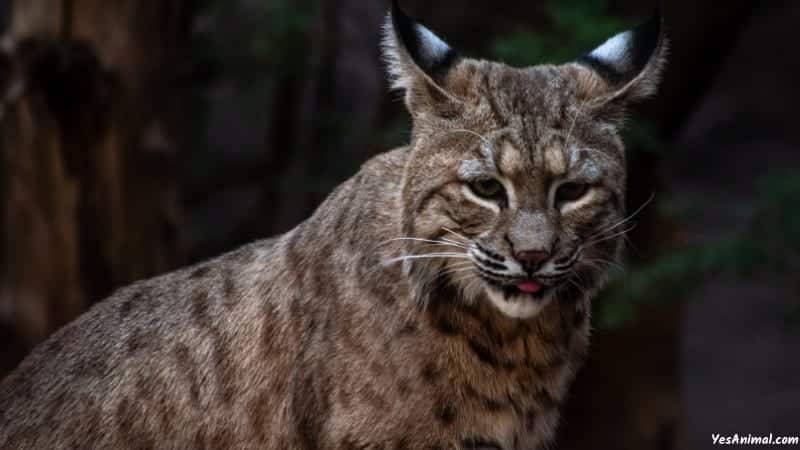Last Updated on April 15, 2024 by Amin Tawar

These creatures are larger than pet cats but smaller than cougars. Known for their distinct stubby or bobbed tail, these felines are found throughout the northern American continent including the state of Wisconsin in the United States. Yeah! We are talking about the bobcats.
Bobcats, members of the lynx family, have roamed the earth’s surface since 2.6 million years ago. Although they enjoy a stable and secure life today, as fellow residents of the state, we need to know about them.
So Below I’ve explained everything you need to know about the Bobcat’s presence in Wisconsin.
Are There Bobcats in Wisconsin?
Yes, Today Wisconsin boasts of an abundant bobcat population. Although, there was a time when you wouldn’t be able to spot even one bobcat in the state’s densest forests.
These cats were extensively targeted by bounty hunters and trappers as game. Add to this, there was also rapid and widespread deforestation that reduced these wildcats’ home range.
Slowly but surely, many conservationists and even the state introduced laws and regulations to control Bobcat hunting and trapping. As a result, today, these resilient creatures are found across the state in diverse habitats.
Where do bobcats live in Wisconsin?
Wisconsin is home to a diverse range of habitats from dense forests to eye-catching lakes. These natural habitats also are home to a variety of animals including bobcats.
As bobcats prefer to live in forested areas with dense cover, they are mostly spotted in pristine wilderness areas of Wisconsin. Although their distribution is not uniform across these areas, Bobcats have been occasionally sighted in the Northern, central, and southern regions of Wisconsin due to both the availability of suitable habitat and the availability of a stable prey population.
How common are bobcats in Wisconsin?

Bobcats are much more common than other wildcats found in the state. However, bobcats are shy and solitary creatures that tend to avoid human encounters. Additionally, these felines also have reddish tan fur with striped faces and mottled spots on their body which makes them much more difficult to be spotted in the jungle.
While a precise population of Bobcats in Wisconsin cannot be provided, the Wisconsin Department of Natural Resources is working on it.
From extensive tracking to spreading awareness to the public, the wildlife agency has been putting up efforts to manage and monitor the Bobcat population in the state.
Also Check Our Guide On Bobcats In US
How Large Is a Wisconsin Bobcat?
Be it a bobcat from Wisconsin or any other state, they are of medium size and weigh about two times of a domestic cat. As per numerous studies and research, Bobcats weigh anywhere between 15 to 30 pounds with the largest bobcat weighing about 40 pounds.
From their nose to tail they are about 2 to 3 feet tall. However, they have muscular bodies and short legs that make them move stealthily without anybody knowing.
Like any other wildlife, even Bobcat’s size depends on various factors like age, health, and access to food. In a gist, Bobcats have muscular and compact body that helps them move with agility and supports them in their hunting.
Are Bobcats Aggressive in Wisconsin?
Bobcats are not known to be aggressive. In fact, these wild cats run away or hide when they see a human nearby. However, at the end of the day, bobcats are wild animals.
Their inherent nature, therefore, makes them defensive and aggressive when they are threatened or cornered. For a female Bobcat, this would be when her little ones are in danger.
Therefore, don’t let their bobcat’s weight and small size fool you. Remember, they are also known to hunt white-tailed deer when the situation demands it.
Can You Kill a Bobcat in Wisconsin?
Yes, you can kill a bobcat in Wisconsin. Compared to other cat populations, Bobcat numbers in the state are thriving.
To control their population which now stands at an estimated 46,000 individuals, the Wisconsin Department of Natural Resources conducts hunting seasons and issued special trapper and hunter licenses and permits.
These permits along with rules and regulations set by the agency aid in the conservation of bobcats in a sustainable way.
An exception to this rule is when a bobcat turns out to be a threat to a human life or a livestock life. In this case, an individual can shoot the cat as an act of self-defence. However, the kill needs to be brought to the wildlife agency immediately so that bobcat numbers could be updated.
Can You Own a Bobcat in Wisconsin?
No, you cannot own a Bobcat in Wisconsin without a permit. In fact, the ownership of Bobcats as a pet is prohibited in most of the bobcats-living states of the country.
Bobcats though less dangerous than their cousins like mountain lions, are wild animals and therefore need to be monitored closely.
The special permits and licenses for Bobcat ownership are strictly regulated and can be attained for specific reasons alone.
These include rehabilitation, education, and research purposes. Overall, while bobcats cannot be legally owned as a pet, they can be possessed with a permit if you have specific purposes as listed by the wildlife agency.
What To Do If You See a Bobcat in Wisconsin?
Don’t worry or panic if you spot a Bobcat in Wisconsin. In most cases, you are more likely to ignore them due to their resemblance to a pet cat. While Bobcats do not pose an immediate danger to a human’s life, it is important that we take precautions.
Bobcats are attracted to human food, pet food, and other food sources. So, avoid keeping food sources including pets and small children outdoors, especially at night. But if you do spot one in the wild, maintain distance and give it some space to move. If it hasn’t sensed your presence yet, stand where you are and make loud noises. In most cases, the bobcat would either run away or hide.
Also Check Our Guide On Bobcats In Maryland
Conclusion
And that was everything you need to know about the Bobcats In Wisconsin. I hope this article was informative and your queries were answered.
Thank You For Reading!
Our Goto Source For This Guide